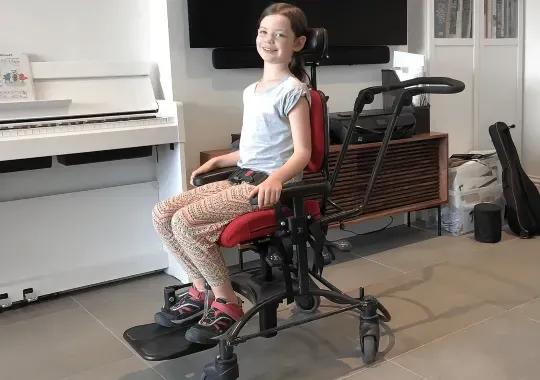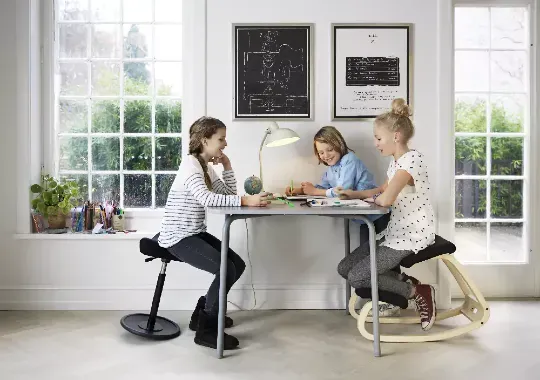Attention-Deficit/Hyperactivity Disorder (ADHD) is more than just a medical term or a diagnosis - it's a unique way of experiencing and engaging with the world. For people living with ADHD, everyday tasks and environments can be laden with challenges that others might not even consider. That's where understanding and adaptation come into play, especially when we think about something as simple yet crucial as a chair.
As Amazon affiliates we may earn a commission if you purchase a product at no cost to you.
ADHD and Its Impact on Daily Life
ADHD is a neurodevelopmental disorder that affects both children and adults. It's often characterized by symptoms such as inattention, hyperactivity, and impulsivity. While these symptoms might sound easy to manage, they can seriously disrupt a person's daily life, affecting their ability to focus, stay still, or even relax. Imagine being in a continuous state of restlessness - it's exhausting!
Why Do Special Chairs Matter for ADHD?
So, what does furniture have to do with all of this, you might ask? When you're constantly on the move or struggling to focus, being comfortable in your own space is crucial. People with ADHD often fidget or move around as a way of self-regulating, helping them to cope with feelings of restlessness or to improve focus. A chair isn't just a chair in this context - it's a potential ally in managing ADHD symptoms.
Special chairs for ADHD are designed with these specific needs in mind. They often incorporate features such as movement, adjustability, and ergonomic design. An ADHD-friendly chair can help promote better focus, reduce restlessness, and even provide a sense of comfort and security that can be extremely helpful in managing the symptoms of ADHD.
As we delve deeper into the topic of "What is a good chair for ADHD?" in the following sections, we'll provide insights into the unique features and benefits of these chairs, along with some top picks. But it's essential to remember that there's no one-size-fits-all solution. ADHD affects everyone differently, and what works for one person might not work for another. In essence, the 'right' chair for ADHD is the one that best supports the individual's unique needs, helping them to navigate their day-to-day life with ease and comfort.
The Connection Between ADHD and Seating
Understanding the connection between ADHD and seating can significantly enhance how we create environments that support individuals with ADHD. The right chair is not just about comfort—it's also about managing symptoms and improving quality of life.
The Role of Seating in Self-Regulation
ADHD often manifests through hyperactivity and restlessness, leading to constant movement and fidgeting. This isn't just a random action, but rather, a self-regulation strategy. Movement can help control challenging emotions, manage distractions, and increase focus. For many people with ADHD, sitting still can be an ordeal, and the 'standard' chair can exacerbate feelings of discomfort or anxiety.
ADHD-friendly chairs, on the other hand, accommodate this need for movement. They might include features like swivel bases, adjustable heights, or even elements like wiggle cushions that allow for controlled, beneficial movement. By working with the person's natural inclinations, these chairs can create a more harmonious and productive environment.
The Impact on Focus and Productivity
Another essential aspect of this connection is the impact on focus and productivity. ADHD can make concentration challenging, leading to difficulties in academic or professional settings. A chair that helps manage hyperactivity can, by extension, improve focus and attention span.
Such chairs may incorporate ergonomic design principles, ensuring that the user's body is properly supported, reducing physical distractions like back pain or muscle strain. By minimizing these distractions, the chair can help individuals with ADHD devote more of their energy and attention to the task at hand.
Aiding in Emotional Comfort
A chair that an individual with ADHD finds comfortable and accommodating can create a sense of security and acceptance, crucial aspects of emotional well-being. Knowing that their environment suits their needs can foster increased self-confidence and decrease stress, which is beneficial for overall mental health.
As we explore what makes a good chair for ADHD, it's crucial to remember these interconnected aspects of seating. An ADHD-friendly chair is not just a piece of furniture; it's a tool that can enhance focus, encourage self-regulation, and foster emotional well-being. The right chair matters because it can significantly contribute to improved daily experiences for individuals with ADHD.
What is a Good Chair for ADHD?
When considering "What is a good chair for ADHD?", it's important to focus on a few key elements that align with the unique needs of individuals with ADHD. These requirements often include flexibility, movement, and ergonomic design.
Flexibility: Accommodating ADHD's Dynamic Nature
ADHD is a dynamic, ever-changing condition. One moment an individual may need to move and fidget, and the next, they may crave stillness and support. As such, a good chair for ADHD is one that offers flexibility. It should easily adjust to the person's needs at a given moment, be it through adjustable heights, tilting mechanisms, or movable armrests.
Movement: The Key to Self-Regulation
The urge to move is a common characteristic of ADHD. To accommodate this, ADHD-friendly chairs often incorporate elements that allow for controlled, productive movement. This could be in the form of a swivel base, a bouncing mechanism, or even a wobble function. Such features can help manage the need for constant movement, providing a physical outlet for restlessness and thus aiding in focus and concentration.
Ergonomic Design: Comfort and Support
Comfort and support are vital for anyone, but they are especially crucial for individuals with ADHD, who might struggle with focus or become easily distracted by physical discomfort. An ergonomically designed chair can offer the needed support for the spine and limbs, reducing fatigue and promoting better focus. Additionally, such chairs often feature quality materials that are not only durable but also provide a tactile sense of comfort and security.
Inclusive and Accepting Environment
In essence, a good chair for ADHD is one that creates an environment of acceptance - a space that works with, not against, the individual's unique needs. It should facilitate their natural tendencies towards movement and change, rather than attempting to limit or control them.
It's all about understanding and embracing the unique experiences and challenges that come with ADHD. The right chair, in this context, becomes a valuable ally, promoting comfort, focus, and self-regulation. And as we'll discuss in the upcoming sections, there's a variety of chairs out there designed with these principles in mind.

The Essential Features of an ADHD-Friendly Chair: What to Look For
Identifying a good chair for ADHD involves understanding key features that cater to the unique needs of individuals with ADHD. Here, we'll spotlight the essential elements that can make a chair genuinely ADHD-friendly.
Movement Mechanisms
Since individuals with ADHD often express a need for motion, chairs that have built-in movement mechanisms are highly beneficial. Look for features such as swivel bases, wobble functions, or bouncing mechanisms. These can help cater to the person's need for movement in a controlled and productive manner.
Adjustable Features
The dynamic nature of ADHD calls for flexibility. Adjustable features like height, tilt, and armrests can be especially useful, allowing the individual to customize the chair to their current needs.
Ergonomic Design
Good ergonomics should never be overlooked. This includes features like supportive backrests, adequate cushioning, and proper arm support, which can help reduce physical stress and distractions, thereby promoting better focus and productivity.
Durable Materials
Since an ADHD-friendly chair might experience more movement and use than a typical chair, durable materials are a must. Look for high-quality, sturdy construction that can withstand constant motion and frequent adjustments.
Tactile Elements
Some individuals with ADHD find certain textures comforting or focus-enhancing. A chair with tactile elements – for instance, a fabric cover rather than a cold, hard surface – could offer an additional layer of support and comfort.
Safety
Last but not least, safety should be a top consideration. Given the movement-oriented design of many ADHD-friendly chairs, it's important to ensure they are safe to use. Features such as a sturdy base and weight limits can prevent accidents and provide peace of mind.
Every person with ADHD is unique. Therefore, a chair that works wonderfully for one individual may not suit another. Knowing what to look for is the first step. The ultimate goal should be to find a chair that supports and facilitates the individual's unique needs, making their daily experiences more comfortable and productive.
Top 5 Chairs for ADHD: Detailed Reviews and Comparisons
When it comes to finding the best chair for ADHD, there's no one-size-fits-all. However, several chairs excel in providing the key features we've discussed. Let's review the top five picks, each offering unique benefits to cater to the varying needs of individuals with ADHD.
The ErgoErgo Active Sitting Stool
This stool promotes active sitting with its unique, wobble-based design. Its durable, lightweight structure and varying sizes make it ideal for all ages. The ErgoErgo allows for easy movement and self-regulation, which can improve focus and productivity.
The Gaiam Balance Ball Chair
The Gaiam Balance Ball Chair cleverly incorporates a yoga ball into its design, allowing for gentle bouncing and active sitting. With adjustable support bars, easy-glide casters, and an air pump included, it merges movement with ergonomic support.
The HÅG Capisco Puls 8010
With its unique saddle seat and fully adjustable features, this chair offers unparalleled flexibility. Its design promotes natural movement, and the sturdy construction ensures it can withstand constant adjustments.
The Kore Wobble Chair
As the name suggests, this chair is all about the wobble. Available in various sizes for kids and adults, it's perfect for those who find rocking or bouncing movements soothing. The sturdy, circular base ensures safety while allowing for 360-degree swiveling.
The Steelcase Gesture Chair
This high-end option is packed with adjustable features for ultimate customization, including seat depth, armrest width and height, tension, and more. Its 3D LiveBack technology adjusts automatically to mimic the natural motion of the spine, providing superior ergonomic support.
Each of these chairs provides unique benefits. While they all promote movement and flexibility, factors such as design, adjustability, and price point vary. So, when determining what is a good chair for ADHD, consider individual needs, preferences, and budget. The ideal chair will harmoniously align with the user's lifestyle, creating a comfortable and supportive environment.

Tips for Choosing the Right Chair for ADHD
Finding the right chair for ADHD involves careful consideration of individual needs, preferences, and lifestyles. Here are a few tips to guide you in the process.
Understand the Individual's Needs
Every individual with ADHD is unique. While some might find a wobble feature beneficial, others may prefer a bouncing mechanism or a swivel base. Understanding the specific needs and preferences of the individual is the first step in choosing the right chair.
Look for Movement Features
Chairs that allow for controlled movement can significantly aid in managing ADHD symptoms. Depending on the individual's preferences, this could mean a wobble chair, a balance ball chair, or a swivel chair.
Prioritize Ergonomic Design
Proper support is crucial for comfort and focus. An ergonomically designed chair can reduce physical discomfort and distractions, helping the individual to concentrate better. Look for features like a supportive backrest, adjustable armrests, and seat height and depth.
Consider Durability and Safety
An ADHD-friendly chair may experience more use and movement than a standard chair. Hence, durability is a key factor. Additionally, safety should be a priority. Ensure the chair has a sturdy base and appropriate weight limit to prevent accidents.
Test It Out
If possible, have the individual try out the chair before purchasing. This can give them a sense of whether the chair's movement mechanisms and adjustments suit their needs and preferences.
Seek Professional Advice
If you're unsure, seek advice from professionals who specialize in ADHD, such as therapists, counselors, or occupational therapists. They can provide valuable insights into what features might be most beneficial.
The right chair for ADHD can significantly enhance focus, improve comfort, and aid in managing symptoms. Take your time, do your research, and choose a chair that can best support the individual's unique needs and enhance their daily experiences.
Transforming Lives with the Right ADHD Chair
Navigating life with ADHD comes with unique challenges and needs. However, these can be substantially eased by making thoughtful, informed choices about our environment, such as selecting the right chair.
The connection between ADHD and seating isn't merely about physical comfort—it's about creating an environment that supports self-regulation, enhances focus, and promotes emotional well-being. ADHD-friendly chairs are specifically designed with these needs in mind, making them more than just a piece of furniture. They're tools that can transform lives.
These chairs work with, rather than against, the tendencies of individuals with ADHD. They facilitate productivity, reduce restlessness, and create a sense of acceptance and comfort that can greatly enhance daily experiences. As we've seen in personal testimonies, the right chair can have a profound impact on ADHD management.
Conclusion
In conclusion, finding the right chair for ADHD can be a significant step towards improving focus, comfort, and overall quality of life. It's about embracing the unique characteristics of ADHD and creating an environment that supports and celebrates these differences. With the right chair, individuals with ADHD can thrive in their daily activities, turning challenges into opportunities for growth and success.
Recommended Article

Frequently Asked Questions FAQs
What is the importance of a chair in managing ADHD symptoms?
A chair designed for individuals with ADHD can help in managing symptoms by providing a means for self-regulation through movement, offering ergonomic comfort, and reducing distractions, thus improving focus and productivity.
What features should I look for in an ADHD-friendly chair?
Look for features that promote controlled movement such as wobble or swivel functions, ensure ergonomic design for comfort, and have adjustable settings for flexibility. The chair should also be made of durable materials to withstand constant movement.
Can the right chair really make a significant difference for individuals with ADHD?
Yes, according to several personal testimonies, the right chair can significantly enhance focus, reduce restlessness, and aid in managing ADHD symptoms, transforming daily experiences for individuals with ADHD.










